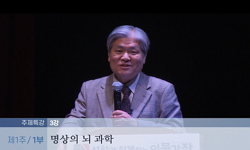실체론에서 관계론으로의 전환을 지향하는 현대 과학의 대표인 시스템 이론과 복잡계 과학에서 관계론은 인과 관계의 비선형성으로 특징지어진다. 비선형 인과란 원인이 결과를 향해 일방...
http://chineseinput.net/에서 pinyin(병음)방식으로 중국어를 변환할 수 있습니다.
변환된 중국어를 복사하여 사용하시면 됩니다.
- 中文 을 입력하시려면 zhongwen을 입력하시고 space를누르시면됩니다.
- 北京 을 입력하시려면 beijing을 입력하시고 space를 누르시면 됩니다.
https://www.riss.kr/link?id=A102649875
- 저자
- 발행기관
- 학술지명
- 권호사항
-
발행연도
2016
-
작성언어
Korean
-
주제어
선형 인과 ; 비선형 인과 ; 피드백 ; 십이연기 ; 자성 ; 공성 ; 뇌 가소성 ; 명상 ; linear causality ; non-linear causality ; feedback ; twelve links of dependent origination ; ??nyat? ; brain plasticity ; meditation
-
KDC
220
-
등재정보
KCI등재
-
자료형태
학술저널
-
수록면
285-304(20쪽)
-
KCI 피인용횟수
1
- DOI식별코드
- 제공처
- 소장기관
-
0
상세조회 -
0
다운로드
부가정보
국문 초록 (Abstract)
그런데 기존의 대다수 학문에서 인과율은 원인에서 결과로 일방적으로 영향을 미친다는 선형 인과로 인식되어왔다. 고대의 이데아론과 중세의 창조론과 근대의 기계론은 모두 인과가 선형적으로 원인에서 결과로 일방향으로만 간다고 본다는 점에서 공통되는데, 이런 선형 인과는 그 일방향성으로 인해 사물과 인간을 위계화하고 도구화하는 데 훌륭한 수단이 될 수 있었다. 그러나 현대의 복잡계 과학에선 이런 인과의 일방향성을 거부하고, 결과도 원인에 영향을 미칠 수 있다는 양방향성의 비선형 인과를 주장한다.
복잡계 과학에서 나타나는 비선형 인과의 방식은 불교 교학의 핵심 개념인 연기와 공에서도 발견된다. 무명과 행, 행과 식, 식과 명색 등 십이연기의 각 관계 항목들에서 결과가 거꾸로 원인에게 그 영향을 피드백하는 비선형적 현상이 나타난다. 그리고 원인과 결과 사이의 비선형적 상호의존성은 인과의 성격이 비실체적 공성임을 함축하고, 이런 인과의 공성은 인선과후(因先果後)의 선형성뿐만 아니라 과선인후(果先因後)의 비선형성도 가능함을 보여준다.
더욱이 인선과후의 선형성과 과선인후의 비선형성 간의 중도적 균형은 정신과 물질, 몸과 마음 혹은 뇌와 마음의 관계에서 균형 잡힌 시각을 제공해준다. 이런 시각은 뇌가 마음을 일으키고 형성하지만, 마음이 변화하면 뇌 역시도 변화한다는 뇌 가소성에서 분명하게 드러난다. 마음의 변화로 뇌의 변화가 일어난다는 비선형적 가소성을 가장 잘 보여주는 것이 불교의 명상 수행인데, 명상을 통한 마음의 변화는 뇌파의 변화와 아울러 뇌구조에 상당한 변화를 가져온다.
실체론에서 관계론으로의 전환을 지향하는 현대 과학의 대표인 시스템 이론과 복잡계 과학에서 관계론은 인과 관계의 비선형성으로 특징지어진다. 비선형 인과란 원인이 결과를 향해 일방향적으로 영향을 미친다는 선형 인과에 대한 거부로서, 결과가 다시 자신의 원인에게 영향을 주어 그 원인을 재구조화한다는 인과의 양방향성을 가리킨다.
그런데 기존의 대다수 학문에서 인과율은 원인에서 결과로 일방적으로 영향을 미친다는 선형 인과로 인식되어왔다. 고대의 이데아론과 중세의 창조론과 근대의 기계론은 모두 인과가 선형적으로 원인에서 결과로 일방향으로만 간다고 본다는 점에서 공통되는데, 이런 선형 인과는 그 일방향성으로 인해 사물과 인간을 위계화하고 도구화하는 데 훌륭한 수단이 될 수 있었다. 그러나 현대의 복잡계 과학에선 이런 인과의 일방향성을 거부하고, 결과도 원인에 영향을 미칠 수 있다는 양방향성의 비선형 인과를 주장한다.
복잡계 과학에서 나타나는 비선형 인과의 방식은 불교 교학의 핵심 개념인 연기와 공에서도 발견된다. 무명과 행, 행과 식, 식과 명색 등 십이연기의 각 관계 항목들에서 결과가 거꾸로 원인에게 그 영향을 피드백하는 비선형적 현상이 나타난다. 그리고 원인과 결과 사이의 비선형적 상호의존성은 인과의 성격이 비실체적 공성임을 함축하고, 이런 인과의 공성은 인선과후(因先果後)의 선형성뿐만 아니라 과선인후(果先因後)의 비선형성도 가능함을 보여준다.
더욱이 인선과후의 선형성과 과선인후의 비선형성 간의 중도적 균형은 정신과 물질, 몸과 마음 혹은 뇌와 마음의 관계에서 균형 잡힌 시각을 제공해준다. 이런 시각은 뇌가 마음을 일으키고 형성하지만, 마음이 변화하면 뇌 역시도 변화한다는 뇌 가소성에서 분명하게 드러난다. 마음의 변화로 뇌의 변화가 일어난다는 비선형적 가소성을 가장 잘 보여주는 것이 불교의 명상 수행인데, 명상을 통한 마음의 변화는 뇌파의 변화와 아울러 뇌구조에 상당한 변화를 가져온다.
다국어 초록 (Multilingual Abstract)
The majority of the existing sciences have historically supported linear causality. The idea of theory in ancient philosophy, the doctrine of creation in the Middle Ages, and mechanical philosophy in the modern era all have the unilateralness of linear causality as a common denominator. Their unilateralization brought about the hierarchy between the human and nature, and hence the instrumentalization of nature. However, contemporary complexity science rejects the unilateralness of linear causality in favor of the bilateralness of -non-linear causality.
The non-linear causality style of complexity science can be found in pratītyasamutpāda and śūnyatā, core constructs of Buddhist doctrine.
Avidyā and saṃskāra, saṃskāra and vijñāna, vijñāna and namarūpa, and so on, in twelve links of dependent origination represent the feedback phenomenon of non-linear causality. The non-linear interdependence between cause and effect implies the non-substantial śūnyatā in causality. This śūnya causation admits not only the linearity of cause first and effect last, but also the non-linearity of effect first and cause last.
The middle way between the linearity of cause coming first and effect last, and the non-linearity of effect first and cause last provides a well-balanced perspective of the relation of mind - matter, mind - body, and mind - brain. - This vision comes out in the plasticity of the brain, which can make alterations in its structure and function through experience and practice, or through thinking and acting by itself. The continuous practice of meditation activates theta and gamma brain waves; strengthens the left prefrontal lobe, related to positive feeling; enlarges the hippocampus and orbitofrontal cortex related to memory and emotion control; activates the parasympathetic nervous system, related to inhibitory and relaxant actions.
Representative of contemporary science, systems theory and complexity science aim at the transition from substance theory to relational theory. In complexity science, relational theory is characterized by the non-linearity of causation. Linear causali...
Representative of contemporary science, systems theory and complexity science aim at the transition from substance theory to relational theory. In complexity science, relational theory is characterized by the non-linearity of causation. Linear causality holds that a cause influences an effect unilaterally, while non-linear causality posits that an effect influences its cause in reverse, and thus restructures the cause. The bilateralness of cause and effect characterizes non-linear causality.
The majority of the existing sciences have historically supported linear causality. The idea of theory in ancient philosophy, the doctrine of creation in the Middle Ages, and mechanical philosophy in the modern era all have the unilateralness of linear causality as a common denominator. Their unilateralization brought about the hierarchy between the human and nature, and hence the instrumentalization of nature. However, contemporary complexity science rejects the unilateralness of linear causality in favor of the bilateralness of -non-linear causality.
The non-linear causality style of complexity science can be found in pratītyasamutpāda and śūnyatā, core constructs of Buddhist doctrine.
Avidyā and saṃskāra, saṃskāra and vijñāna, vijñāna and namarūpa, and so on, in twelve links of dependent origination represent the feedback phenomenon of non-linear causality. The non-linear interdependence between cause and effect implies the non-substantial śūnyatā in causality. This śūnya causation admits not only the linearity of cause first and effect last, but also the non-linearity of effect first and cause last.
The middle way between the linearity of cause coming first and effect last, and the non-linearity of effect first and cause last provides a well-balanced perspective of the relation of mind - matter, mind - body, and mind - brain. - This vision comes out in the plasticity of the brain, which can make alterations in its structure and function through experience and practice, or through thinking and acting by itself. The continuous practice of meditation activates theta and gamma brain waves; strengthens the left prefrontal lobe, related to positive feeling; enlarges the hippocampus and orbitofrontal cortex related to memory and emotion control; activates the parasympathetic nervous system, related to inhibitory and relaxant actions.
목차 (Table of Contents)
- 〈한글요약〉
- Ⅰ. 들어가는 말 - 복잡계 과학과 비선형 인과
- Ⅱ. 인과의 두 방식 - 선형 인과와 비선형 인과
- Ⅲ. 비선형 인과와 관계의 문제 - 연기와 비선형성
- Ⅳ. 비선형 인과와 실체의 문제 - 공성과 비선형성
- 〈한글요약〉
- Ⅰ. 들어가는 말 - 복잡계 과학과 비선형 인과
- Ⅱ. 인과의 두 방식 - 선형 인과와 비선형 인과
- Ⅲ. 비선형 인과와 관계의 문제 - 연기와 비선형성
- Ⅳ. 비선형 인과와 실체의 문제 - 공성과 비선형성
- Ⅴ. 비선형 인과와 수행의 문제 - 뇌가소성과 명상
- Ⅵ. 맺는 말 - 과학 시대의 불교
- 〈참고문헌〉
- 〈Abstracts〉
참고문헌 (Reference)
1 일리야 프리고진, "혼돈 속의 질서" 민음사 1990
2 르네 요한슨, "초기불교의 역동적 심리학" 경희대출판국 2008
3 제임스 오스틴, "선과 뇌의 향연" 대숲바람 2012
4 안지영, "불교 명상을 통한 심신치유의 뇌과학적 이해" 한국불교연구원 (41) : 447-479, 2014
5 최종덕, "부분의 합은 전체인가" 소나무 1995
6 김종욱, "복잡계로서 생태계와 법계" 철학사상연구소 (41) : 7-36, 2011
7 윤영수, "복잡계개론" 삼성경제연구소 2006
8 장현갑, "뇌를 움직이는 마음의 비밀" 담앤북스 2013
9 龍樹, "十二門論"
10 龍樹, "中論"
1 일리야 프리고진, "혼돈 속의 질서" 민음사 1990
2 르네 요한슨, "초기불교의 역동적 심리학" 경희대출판국 2008
3 제임스 오스틴, "선과 뇌의 향연" 대숲바람 2012
4 안지영, "불교 명상을 통한 심신치유의 뇌과학적 이해" 한국불교연구원 (41) : 447-479, 2014
5 최종덕, "부분의 합은 전체인가" 소나무 1995
6 김종욱, "복잡계로서 생태계와 법계" 철학사상연구소 (41) : 7-36, 2011
7 윤영수, "복잡계개론" 삼성경제연구소 2006
8 장현갑, "뇌를 움직이는 마음의 비밀" 담앤북스 2013
9 龍樹, "十二門論"
10 龍樹, "中論"
11 龍樹, "The Dialectical Method of Nagarjuna" MotilalBanarsidass 1978
12 Stcherbatsky, Th., "The Conception of Buddhist Nivana" 1927
13 "Saṃyutta-nikāya"
14 Platon, "Politeia"
15 Macy, J.., "Mutual Causality in Buddhism and General Systems Theory" State University of New York Press 1991
16 Aristoteles, "Metaphysica"
17 "Majjhima-nikāya"
18 Kant, "Kritik der reinen Vernunft"
19 Koestler, "Ghost in the Machine" Hutchinson 1967
20 Shatz, C. L., "Dividing up the neocortex" 258 : 237-238, 1992
21 Kalupahana, D., "Causality: The Central Philosophy of Buddhism" University Press of Hawaii 1975
22 Azari, N. P., "Brain Plasticity and Recovery from Stroke" 88 : 426-431, 2000
23 Hume, D., "A Treatise of Human Nature" Oxford University Press 1980
동일학술지(권/호) 다른 논문
-
Dharmakīrti(法稱)가 비판한 상키야 지각설의 쟁점
- 동국대학교 불교문화연구원
- 정승석(Jung, Seung-Suk)
- 2016
- KCI등재
-
- 동국대학교 불교문화연구원
- 조준호(Cho, Joon-Ho)
- 2016
- KCI등재
-
- 동국대학교 불교문화연구원
- 최은영(Choi, Eun-Young)
- 2016
- KCI등재
-
- 동국대학교 불교문화연구원
- 박재용(Park, Jae-Yong)
- 2016
- KCI등재
분석정보
인용정보 인용지수 설명보기
학술지 이력
| 연월일 | 이력구분 | 이력상세 | 등재구분 |
|---|---|---|---|
| 2028 | 평가예정 | 재인증평가 신청대상 (재인증) | |
| 2022-09-16 | 학회명변경 | 영문명 : Institute for Buddhist Culture -> Buddhist Culture Research Institute |  |
| 2022-01-01 | 평가 | 등재학술지 유지 (재인증) |  |
| 2019-01-01 | 평가 | 등재학술지 유지 (계속평가) |  |
| 2016-01-01 | 평가 | 등재학술지 유지 (계속평가) |  |
| 2013-01-23 | 학회명변경 | 영문명 : The Korean Buddhist Research Institute -> Institute for Buddhist Culture |  |
| 2012-01-01 | 평가 | 등재학술지 유지 (등재유지) |  |
| 2009-01-01 | 평가 | 등재학술지 선정 (등재후보2차) |  |
| 2008-01-01 | 평가 | 등재후보 1차 PASS (등재후보1차) |  |
| 2007-01-01 | 평가 | 등재후보학술지 유지 (등재후보2차) |  |
| 2006-01-01 | 평가 | 등재후보 1차 PASS (등재후보1차) |  |
| 2004-01-01 | 평가 | 등재후보학술지 선정 (신규평가) |  |
학술지 인용정보
| 기준연도 | WOS-KCI 통합IF(2년) | KCIF(2년) | KCIF(3년) |
|---|---|---|---|
| 2016 | 0.73 | 0.73 | 0.69 |
| KCIF(4년) | KCIF(5년) | 중심성지수(3년) | 즉시성지수 |
| 0.63 | 0.55 | 1.313 | 0.17 |





 KCI
KCI DBpia
DBpia







